The correct way to see Guilin and its attractions is to visit Longji first after arriving in Guilin because Longji is north of Guilin and all the other attractions are in the south. You don't want to do the south and lug all your luggage (which will build up as you go) up to the north like we did. Longji is famous for its terraced rice fields, golden in the fall and green in summer. Two hours north of Guilin by car or bus, Longji is the one place I want to visit again some day.
Instead of going to Longji, I decided that we should go to Haiyang Xiang, a small town 1 hour's drive south of Guilin, because I wanted to catch the gingko trees in their golden splendor. Haiyang Xiang is famous for its aged gingko trees; the oldest tree we saw was 1,600 years old. Gingko trees are considered living fossils.
We hired a taxi from Guilin to Daxu, a town halfway to Haiyang Xiang, for 60 Yuan/RM30/US$8. The great thing about taxis in China is that our family of five can all sit in one car. It is only slightly more expensive to move around in a taxi than a bus but you can make stops wherever you like and there's no schedule to stick to. We made a stop for breakfast at the driver's fav Guilin mifen shop and my kids now remember the mifen as the best Guilin mifen. Unfortunately my daughter lost the memory card of the photos she took on the first 2 days and I don't have the photo of the shop to show. Nearly all shops and other buildings in Guilin don't have signs in English so it is rather hard for people who can't read Chinese.
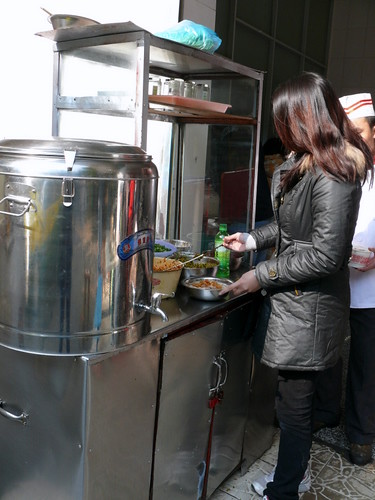
After getting your bowl of mifen, you go to the condiments station and choose your choice of toppings. The large stainless steel pot holds the soup.

The toppings are pickled long beans, dried radish, Guilin chili sauce, fresh chopped chilies, spring onions and crispy fried soya beans which I prefer to the fried peanuts that some shops serve. Guilin mifen is very simple, humble food but it is SO delicious! The noodles are super smooth and silky even though they are made from dried noodles. I don't know why we can't find them in Malaysia because they are exactly the same thickness of assam laksa noodles, except our noodles are coarser, drier and lack the fragrance of rice.
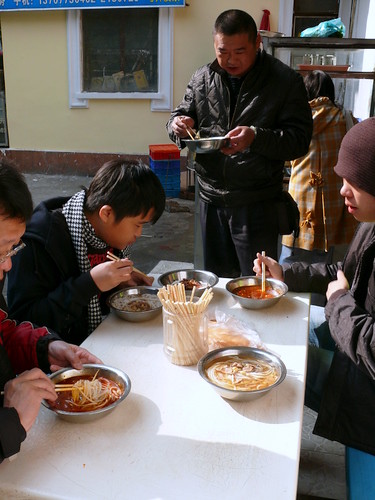
The driver wouldn't sit down with us and ate his noodles standing up, which I found was common practice in small towns.
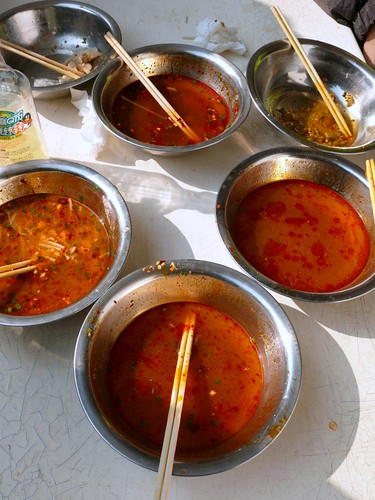
You can imagine how hot the stuff was. We realized after this that we had to go easy on the chili. Imagine chopped birds eyes chilies (yes, they have them in China) and Guilin chili sauce in your noodles. The driver also taught us to eat our mifen without the soup first and add soup halfway so we get to taste both dry and soupy noodles. Clever but I still prefer my noodles in soup especially on a cold day.
We stopped by the town of Daxu to visit the ancient street but for me, it was mainly to eat the best bowl of Guilin mifen which I had 3 years ago. Unfortunately, the restaurant had been renovated and I wasn't sure if the cook was the same one so we went to another shop a couple of doors away which was filled with locals. It looked dirty ("dodgy" in my kids' words; they used that word so many times in reference to so many things in China that my husband banned it). The Guilin mifen was great, a bit too oily, and I felt uneasy eating it.
For 2 Yuan/RM1/US$0.28, you can visit one of the old houses. It was so cheap Hub paid the couple double.
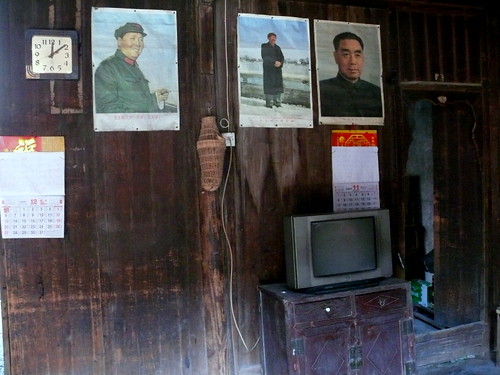
You enter into the hall/sitting room where pictures of Mao and Chou remind you that you are in communist China.
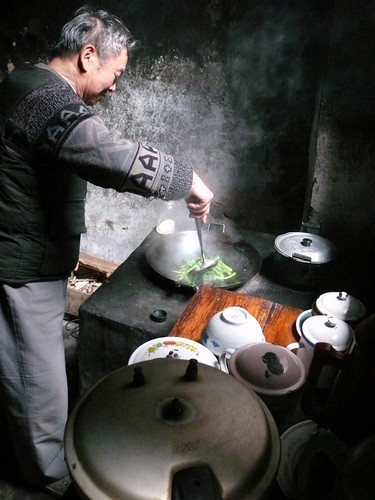
The husband was cooking lunch (fried greens; it looked delicious) on a firewood stove, much like the rest of rural China.
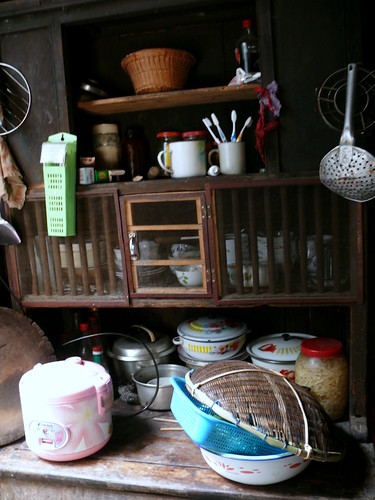
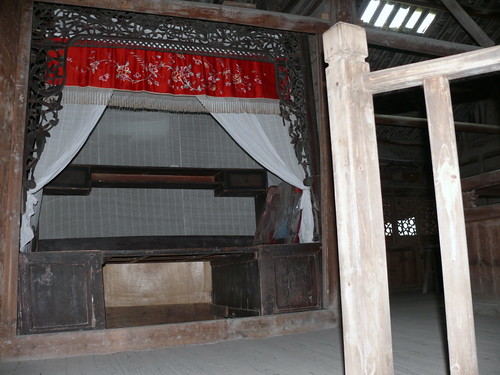
Upstairs, the wooden bed is typically set by the side of a wall, and mosquito nets drape the canopy. The bed area used to be a small silo for unmilled rice.
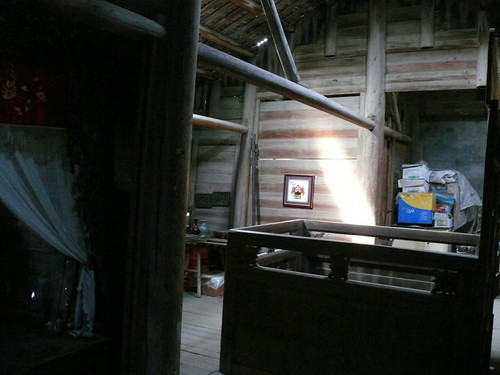
The house has many skylights to illuminate it, reminding me of Baba Nyonya houses. This skylight shines into the courtyard below and the 'well' allows you to see into the courtyard.
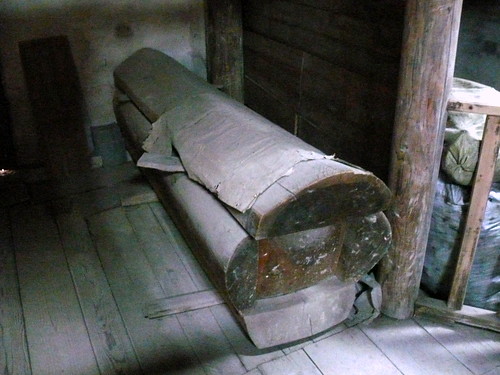
At the corner of the room, a dusty Chinese coffin made my heart jumped. The wife said this was 'investment for the future' and I politely nodded. Many older Chinese make preparations for their death, buying shoes, clothes and coffins. This coffin is made from a large tree, and it still scares me to see one because when I was little, there were a couple of casket shops in Menggatal that freaked me out when we drove by because I had never been to a funeral. Chinese coffins look extra spooky to me and I am surprised by the sombreness in this photo. However, my kids didn't find it any spookier than a log so I think it's conditioning of the mind.
Instead of going to Longji, I decided that we should go to Haiyang Xiang, a small town 1 hour's drive south of Guilin, because I wanted to catch the gingko trees in their golden splendor. Haiyang Xiang is famous for its aged gingko trees; the oldest tree we saw was 1,600 years old. Gingko trees are considered living fossils.
We hired a taxi from Guilin to Daxu, a town halfway to Haiyang Xiang, for 60 Yuan/RM30/US$8. The great thing about taxis in China is that our family of five can all sit in one car. It is only slightly more expensive to move around in a taxi than a bus but you can make stops wherever you like and there's no schedule to stick to. We made a stop for breakfast at the driver's fav Guilin mifen shop and my kids now remember the mifen as the best Guilin mifen. Unfortunately my daughter lost the memory card of the photos she took on the first 2 days and I don't have the photo of the shop to show. Nearly all shops and other buildings in Guilin don't have signs in English so it is rather hard for people who can't read Chinese.

After getting your bowl of mifen, you go to the condiments station and choose your choice of toppings. The large stainless steel pot holds the soup.

The toppings are pickled long beans, dried radish, Guilin chili sauce, fresh chopped chilies, spring onions and crispy fried soya beans which I prefer to the fried peanuts that some shops serve. Guilin mifen is very simple, humble food but it is SO delicious! The noodles are super smooth and silky even though they are made from dried noodles. I don't know why we can't find them in Malaysia because they are exactly the same thickness of assam laksa noodles, except our noodles are coarser, drier and lack the fragrance of rice.

The driver wouldn't sit down with us and ate his noodles standing up, which I found was common practice in small towns.

You can imagine how hot the stuff was. We realized after this that we had to go easy on the chili. Imagine chopped birds eyes chilies (yes, they have them in China) and Guilin chili sauce in your noodles. The driver also taught us to eat our mifen without the soup first and add soup halfway so we get to taste both dry and soupy noodles. Clever but I still prefer my noodles in soup especially on a cold day.
We stopped by the town of Daxu to visit the ancient street but for me, it was mainly to eat the best bowl of Guilin mifen which I had 3 years ago. Unfortunately, the restaurant had been renovated and I wasn't sure if the cook was the same one so we went to another shop a couple of doors away which was filled with locals. It looked dirty ("dodgy" in my kids' words; they used that word so many times in reference to so many things in China that my husband banned it). The Guilin mifen was great, a bit too oily, and I felt uneasy eating it.
For 2 Yuan/RM1/US$0.28, you can visit one of the old houses. It was so cheap Hub paid the couple double.

You enter into the hall/sitting room where pictures of Mao and Chou remind you that you are in communist China.

The husband was cooking lunch (fried greens; it looked delicious) on a firewood stove, much like the rest of rural China.


Upstairs, the wooden bed is typically set by the side of a wall, and mosquito nets drape the canopy. The bed area used to be a small silo for unmilled rice.

The house has many skylights to illuminate it, reminding me of Baba Nyonya houses. This skylight shines into the courtyard below and the 'well' allows you to see into the courtyard.

At the corner of the room, a dusty Chinese coffin made my heart jumped. The wife said this was 'investment for the future' and I politely nodded. Many older Chinese make preparations for their death, buying shoes, clothes and coffins. This coffin is made from a large tree, and it still scares me to see one because when I was little, there were a couple of casket shops in Menggatal that freaked me out when we drove by because I had never been to a funeral. Chinese coffins look extra spooky to me and I am surprised by the sombreness in this photo. However, my kids didn't find it any spookier than a log so I think it's conditioning of the mind.

5 comments:
I am reading Wild Swan for the 2nd time and my visual while reading is how basic life was then (and maybe now). Your pictures speak the lives of people then and now.
Yeah..scary. We went to visit one of the old house and in there the old couple have a coffin in there too. They were preparing for their future too.
Thanks for sharing all your photos and souvenirs . As usual, it's a pleasure to read your blog .
Do you still have the taxi contact number? Also is it saved just to hired any taxi driver?
Goede manier van beschrijven, en leuk artikel om feiten te verzamelen over mijn presentatie onderwerp,
Post a Comment